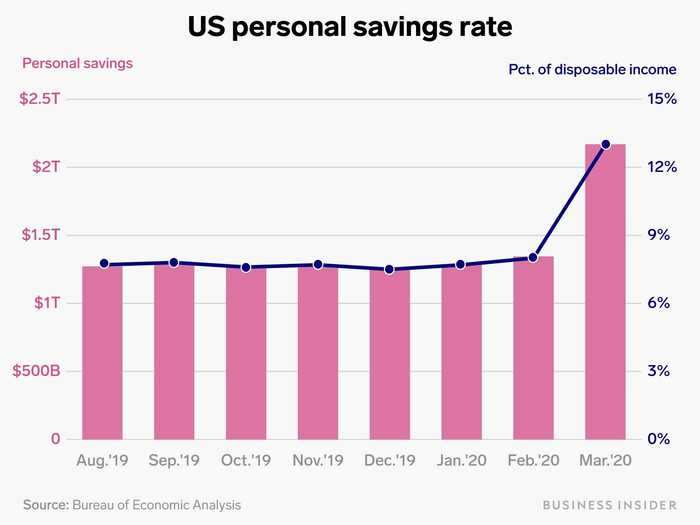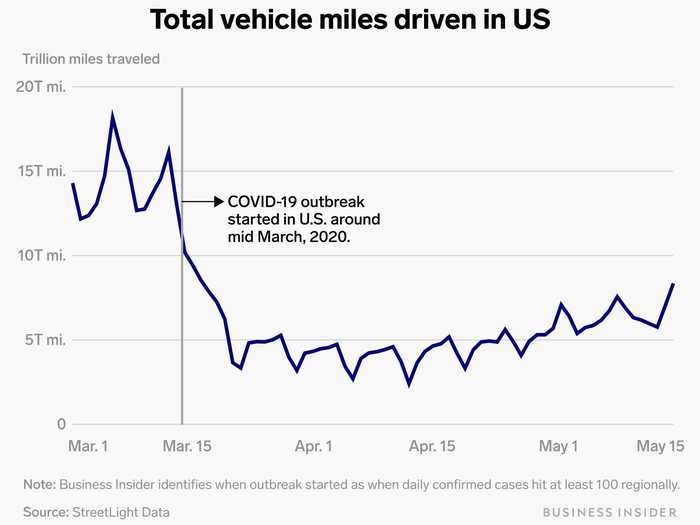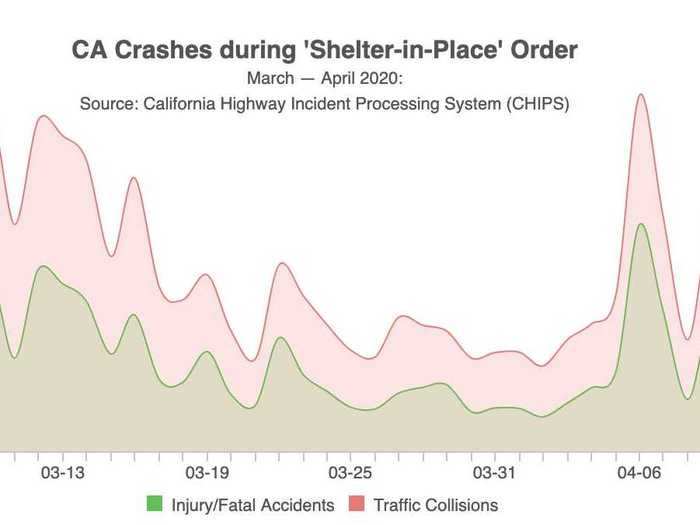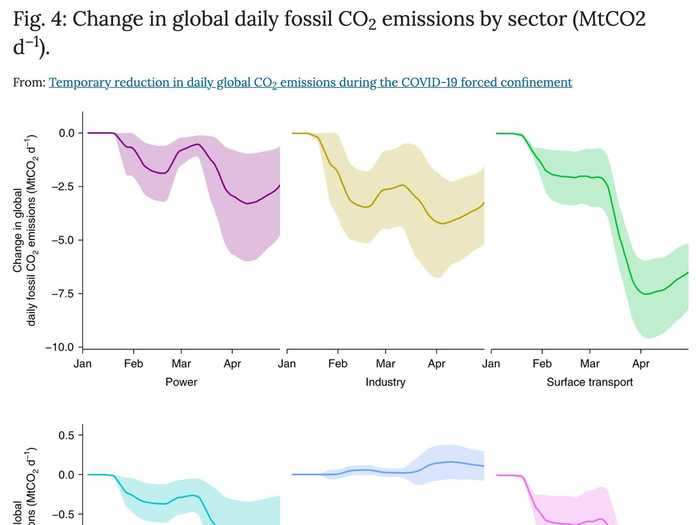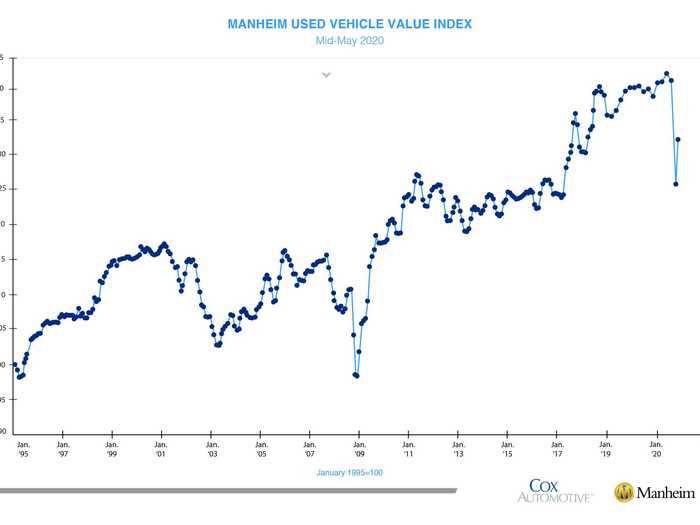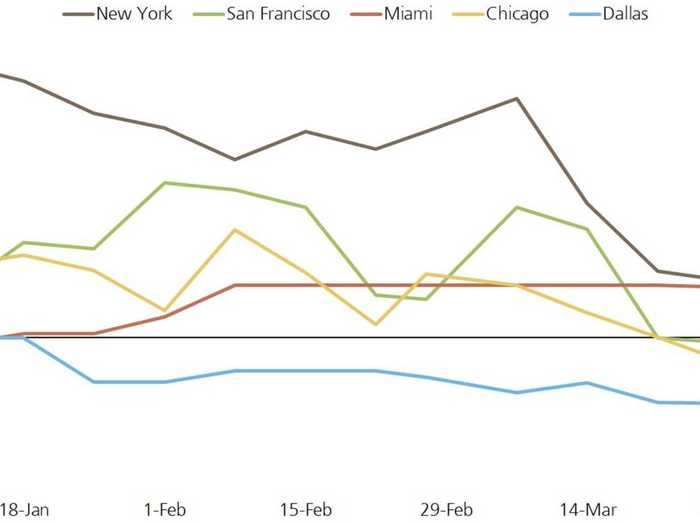An aerial view of light traffic on Hollywood Boulevard (L) and the 101 freeway mid-morning amidst the coronavirus pandemic on April 18, 2020 in Los Angeles, California. Environmental Protection Agency (EPA) data from March showed that Los Angeles had its longest stretch of air quality rated as ‘good’ since 1995 during ‘Safer at Home’ orders given in response to the spread of COVID-19.Mario Tama/Getty Images
- More than 100,000 Americans have died from COVID-19, the disease caused by the novel coronavirus.
- To slow the spread, officials have implemented varying forms of shelter-in-place orders and closed businesses.
- A side-effect of those closures has meant an uptick in savings, cleaner air, and cheaper cars and homes, among others.
- Here are seven charts that show a bit of silver lining to the crisis.
By all measures, the coronavirus pandemic has crippled the United States economy: Unemployment is at record highs, lines for food banks circle entire city blocks, and the rate of business bankruptcies has accelerated.
But there are small glimmers of hope to be found in the new reality.
These aren't meant to diminish the suffering, of course, and pale in comparison to the pain inflicted by more than 100,000 deaths in the United States alone at the hands of COVID-19, the disease caused by the novel coronavirus. Taken together with the outpouring of economic data, these charts offer a brief respite to gloom.
Ripped from their usual habits, Americans unable to go to concerts, bars, or out to eat significantly padded their savings accounts. Stuck at home, less driving meant fewer accidents and the cleanest air that smog-choked cities have breathed in decades.
Here are seven charts that offer a silver lining to the crisis:
Read the original article on
Business Insider
1. People are saving more money
Ruobing Su/Business Insider
Americans more than doubled their savings in March, lifting their percentage of disposable income saved to 13% from 8%, according to data from the Bureau of Economic Analysis.
With little entertainment options on which to spend money, and most bars and restaurants closed from March into April, that trend is likely to continue when data for April is released at the end of May. Consumer spending, expectedly, also took a 7.5% nosedive.
"The decline in March personal income and outlays was, in part, due to the response to the spread of COVID-19, as governments issued "stay-at-home" orders," the agency said. "This led to rapid changes in demand, as businesses and schools switched to remote work or canceled operations, and consumers canceled, restricted, or redirected their spending."
2. Americans are driving way less than usual
Ruobing Su/Business Insider
Americans love to drive, but shelter-in-place orders caused bustling freeways to become ghost towns. According to numbers from StreetLight Data, which monitors county-level driving activity across the country, total vehicle miles traveled in the US fell 86% from 18.2 million on March 6 to a low of 2.4 million on April 12.
And as those miles slowly start to tick back up, some cities are taking advantage of the pause to enshrine more space for pedestrians, bicycles, and even outdoor cafes. Places like Oakland, California, Seattle, Philadelphia, and Minneapolis have collectively banned cars from hundreds of miles of streets to enable outdoor exercise for their residents — a trend activists hope can continue into the future.
3. Less driving has meant far fewer accidents
The big spikes in crashes on April 6 and April 10 were due to heavy rainfall, the researchers said.
UC Davis
In California alone, drivers caused more than 15,000 fewer crashes in April as the state issued shelter-in-place orders that emptied its notoriously crowded freeways. That's about half of the average rate before the pandemic hit.
Researchers at the University of California, Davis estimated in April that the steep declines — with exceptions for days of rare rainfall in the usually dry state — helped save drivers $40 million every day, inclusive of property damage, lost time, insurance claims, and the cost of emergency response.
Of course, other drivers took advantage of the empty streets to set new records and have some dangerous fun. Police departments across the country told Business Insider that they're struggling to crack down on a "free for all" of street racers. Arresting them poses other challenges too, like risking exposing officers and other staff to the virus.
Arity, a company founded by the insurance giant Allstate, says its data has confirmed the trend, with a 50% increase in confirmed crashes where the speed prior to impact was above 70 miles per hour.
4. The air hasn't been this clean in decades
Coupled with the standstill in aviation, carbon emissions have fallen drastically since March, leading to some of the cleanest air in a generation. New research published in the journal Nature Climate Change on May 19 quantified the temporary impact, and found a 17% reduction in greenhouse emissions in April. That's equivalent to levels not seen since 2006.
But the authors warned that without purposeful shifts to renewable sources, the climate changing emissions won't stay at the artificially deflated levels long, especially when normal levels of activity come back. Total emissions for the year are only projected to fall about 4%.
5. For used cars, it's a buyers market
Cox Automotive
For better or worse, Americans aren't going to give up their personal vehicles anytime soon. Luckily for those who might need a new car in the coming months, a glut of supply from car-rental companies selling their older models is set to flood the markets and send prices plummeting to levels not seen since the last recession, according to JPMorgan.
Data from Mannheim, which tracks the used vehicle market, already shows a deep decline in second-hand sale prices through the beginning of May. Another industry watcher, JD Power, says total auto sales will likely still be below last year's levels even by July.
6. Crime is falling in many cities
NYPD
Many US cities saw a drop in crime as the coronavirus began to take hold in March. According to data from the Police Executive Research Forum, violent crimes fell in 18 of 30 cities the think tank looked at from mid-March to mid-June, compared to the same period last year.
New York saw a nearly one-third decrease in overall crime, but like some other large cities, auto theft and retail burglary were up as cars and business sat empty. Combined, the 30 studied cities saw a 11.5%t decrease in violent crime, and 23% dip in property crime, the group told the Washington Post.
7. Homes are getting cheaper
UBS Evidence Lab
Housing prices have fallen significantly in expensive markets like New York, according to the investment bank UBS. And after rising for the past year, even flat prices could be a tailwind for hopeful home buyers, especially coupled with low mortgage rates thanks to the Federal Reserve. San Francisco, Miami, and Chicago also saw slight declines in median housing prices, the bank found.

